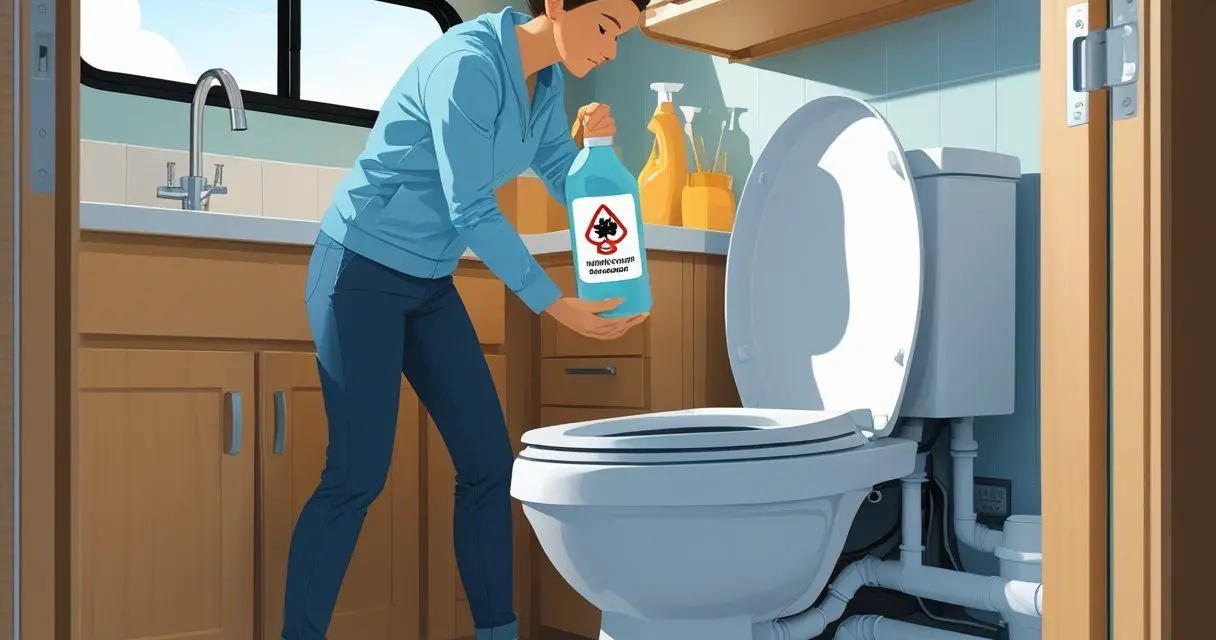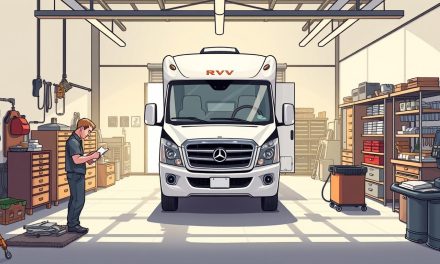Would you like to save this article?
When your RV toilet clogs, it’s tempting to reach for a quick fix like Drano. After all, it works fast in a home bathroom, so why not in your RV?
You should not use Drano in an RV toilet because its harsh chemicals can damage the plumbing, seals, and holding tanks.
RV plumbing is built differently than household systems, using lighter materials that can’t handle strong chemical cleaners. Drano can also kill the good bacteria in your tank that help break down waste, leaving you with bigger problems later.
Instead of risking costly repairs, you have safer and more effective options to clear or prevent clogs. Knowing what works for RV toilets will save you frustration and keep your system running smoothly.
Key Takeaways
- Drano is unsafe for RV toilets and can cause damage
- RV plumbing requires gentler methods to handle clogs
- Safe alternatives and regular care prevent most problems
Can You Use Drano in an RV Toilet?
Drano can clear clogs quickly, but its chemical makeup is not designed for RV plumbing systems. Using it in your RV toilet can create more damage than benefit, especially to seals, tanks, and pipes that are not built to handle harsh cleaners.
Drano’s Intended Use and Ingredients
Drano is made for household drains that connect to municipal sewer or septic systems. It works by breaking down clogs with a mix of sodium hydroxide (lye), aluminum, sodium chloride, and other chemicals.
These ingredients create heat and reactions that dissolve hair, grease, and organic matter. In a home, pipes are usually metal or heavy-duty PVC, which can tolerate these reactions.
RV plumbing, however, is built with lighter materials like PEX piping, plastic fittings, and rubber seals. These are not designed to withstand the same chemical stress.
Drano is not a cleaning product. It’s a chemical reaction tool meant only for short-term contact with clogs. Leaving it in an RV toilet or black tank can cause ongoing damage.
Risks of Using Drano in RV Plumbing
The most immediate risk is damage to rubber seals around your RV toilet and dump valves. These seals keep waste and odors contained.
Strong chemicals like Drano can dry them out or cause them to crack. Another problem is the black tank. Harsh cleaners can weaken the plastic walls of the tank and create leaks.
Heat from chemical reactions may also warp or stress the material. You also risk harming your RV’s septic balance.
Beneficial bacteria in the holding tank help break down waste. Drano kills these bacteria, which can lead to clogs, odors, and poor tank performance.
Repairs from chemical damage are often expensive and may require replacing plumbing parts or even the entire tank system.
How RV Toilet and Waste Systems Work
An RV toilet connects to a holding system that manages waste differently than a household setup. Instead of a direct sewer line, waste collects in a black water tank, which you empty through a controlled valve system.
Understanding these parts helps you maintain your RV plumbing and avoid unnecessary damage.
Understanding the Black Water Tank
The black water tank stores all waste and toilet paper that goes down your RV toilet. Unlike a home sewer system, nothing flows away immediately.
Instead, the tank holds the material until you empty it at a dump station. Most tanks are made of durable plastic and vary in size from 20 to 50 gallons.
The capacity depends on your RV model. Inside the tank, waste breaks down with the help of water and often chemical or enzyme treatments.
These additives help reduce odor and prevent clogs. Without enough water, solids can pile up and form what many RV owners call a “pyramid plug.”
Key points about black water tanks:
- They only hold toilet waste.
- They require frequent emptying.
- Water and treatments help keep them manageable.
Role of the Black Tank Valve
The black tank valve is the part that controls when waste leaves the tank. It sits at the outlet pipe and uses a sliding mechanism to open or close the flow.
You should only open this valve when you are ready to dump the tank. Leaving it open while connected to a sewer hookup can cause liquids to drain out while solids remain, leading to hardened buildup inside.
The valve usually connects to a sewer hose during dumping. Once opened, gravity pulls the contents out of the tank.
After emptying, flushing the tank with clean water helps remove leftover debris and reduces odors. If the valve becomes damaged, leaks or clogs can occur.
Regular inspection and proper use extend its life and keep your system working smoothly.
Typical RV Toilet Design
An RV toilet looks similar to a home toilet but works differently. Instead of a water-filled bowl, it has a small water seal and a direct connection to the black tank.
When you press the pedal or handle, the toilet opens a valve that lets waste fall into the tank. At the same time, water rinses the bowl to help move material down.
Most RV toilets use lightweight plastic parts to reduce weight. Some higher-end models may use porcelain for durability.
Rubber seals inside the toilet keep odors from escaping and ensure the flushing valve closes tightly.
Main features of RV toilets include:
- A foot pedal or lever flush system.
- Direct connection to the black water tank.
- Rubber seals that require care to prevent leaks or odor.
Because of these design differences, harsh chemicals can damage seals or plastic parts. Using RV-safe products helps protect the toilet and waste system.
Why Drano Is Not Recommended for RV Toilets
Drano contains harsh chemicals that can weaken RV plumbing, harm the black water tank system, and create health and environmental risks. While it is effective in household drains, RV systems use lighter materials and rely on bacteria that Drano can easily destroy.
Potential Damage to RV Plumbing
RV plumbing is built with lightweight plastic pipes and rubber seals instead of the heavier metal pipes found in homes. The caustic chemicals in Drano, such as sodium hydroxide, generate heat and corrosion that can soften, warp, or crack these materials.
Rubber seals around fittings and connections are especially vulnerable. Once they degrade, leaks can develop and repairs often require replacement parts that are not simple or cheap to install.
Using Drano in an RV toilet also increases the chance of damaging the toilet bowl itself. Unlike porcelain in many household toilets, RV toilets often use plastic that does not tolerate prolonged exposure to corrosive cleaners.
Key risks include:
- Cracked or weakened plastic pipes
- Damaged toilet bowl surface
- Deteriorated rubber seals causing leaks
Impact on Black Water Tank and Valves
Your RV’s black water tank depends on a balance of bacteria to break down waste and toilet paper. Drano kills this bacteria, leaving solids harder to manage and increasing the chance of clogs.
The black tank valve, which controls waste flow during dumping, also relies on rubber seals. Harsh chemicals can eat away at these seals, leading to stuck or leaking valves.
A leaking valve can cause waste to seep out before you are ready to empty the tank. Once the bacteria are gone, you may need to use more chemicals or treatments to restore balance.
This adds cost and maintenance work that could have been avoided by skipping chemical drain cleaners in the first place.
Possible consequences:
- Reduced waste breakdown in the tank
- Stuck or leaking black tank valve
- Extra maintenance to restore tank function
Safety and Environmental Concerns
Drano produces fumes that can irritate your eyes, skin, and lungs. RV bathrooms are small, enclosed spaces with less ventilation, which increases your exposure to these fumes.
Spills or splashes can also burn skin or damage surfaces inside the RV. When you dump your black water tank, any remaining Drano flows into the sewer or septic system.
These chemicals are not environmentally friendly and can harm septic systems or contaminate soil and water in dump stations. Even after use, the liquid inside your tank may stay hot and caustic for a period of time.
This makes handling waste riskier and increases the chance of injury if splashes occur during draining.
Concerns include:
- Toxic fumes in small RV spaces
- Chemical burns from splashes
- Environmental harm at dump sites
Safe Alternatives to Drano for Unclogging RV Toilets
You can clear most RV toilet clogs without using harsh chemicals. Safer options focus on protecting your plumbing system, keeping seals intact, and avoiding damage to holding tanks.
RV-Safe Toilet Chemicals
RV-safe toilet chemicals are designed specifically for portable and mobile plumbing systems. These products break down waste and paper without harming plastic pipes or rubber seals.
They also help control odors in the black tank. You can find them in liquid, drop-in, or powder form.
Drop-in packets are convenient because they dissolve quickly and require no measuring. Liquids often work faster but can be messy to store.
Powders are lightweight and easy to carry. When choosing a product, look for labels that say septic safe or formulated for RV use.
Avoid chemicals with formaldehyde, as they can damage tanks and create disposal issues at dump stations.
Manual Unclogging Methods
Mechanical tools can clear clogs without adding chemicals to your system. A flexible toilet wand or plumbing snake can reach into the drain line and break up blockages.
These tools are especially useful for clogs caused by excess toilet paper. Pouring boiling water into the toilet can also help soften and loosen waste.
You may need to repeat this step several times. Let the hot water sit for a few hours before flushing it through.
If the clog sits deeper in the tank, you can use a backflush system attached to the sewer outlet. This method pushes water backward through the line to clear stuck material.
It’s effective but requires access to a water hose connection.
Using Biodegradable Enzyme Cleaners
Enzyme-based cleaners use natural bacteria and enzymes to break down organic waste. They are gentle on seals and safe for plastic pipes, making them a good choice for regular maintenance.
These cleaners work more slowly than chemical drain openers, so they are best for soft clogs or preventing buildup. You usually pour the solution into the toilet and let it sit for several hours or overnight.
Many RV owners use enzyme cleaners monthly to keep tanks clear and reduce odors. Since they are biodegradable and septic safe, they are also easier on the environment compared to chemical-based options.
Preventing Clogs and Maintaining Your RV Toilet
Keeping your RV toilet and black water tank in good condition depends on how you use toilet paper, what chemicals you add, and how you flush and clean the system. Small changes in habits can reduce clogs, protect seals, and extend the life of your plumbing.
Proper Use of Toilet Paper and Chemicals
Use RV-safe toilet paper that breaks down quickly in water. Regular household toilet paper may not dissolve fast enough, leading to buildup in the black water tank.
Even if a brand claims to be “septic safe,” it’s best to choose paper made specifically for RV systems. Limit how much paper you use at one time.
If needed, flush more than once during use to prevent large amounts of paper from sitting in the pipe. This lowers the chance of a blockage forming before waste reaches the tank.
Add the right toilet chemicals to help break down solids and control odors. Enzyme-based products are common because they help waste decompose without harming the tank.
Avoid strong chemical cleaners like Drano or bleach, which can damage seals, valves, and the bacteria that help process waste.
Routine Black Tank Maintenance
Keep the black water tank at least one-third full before dumping. Liquids help solids move out of the tank more easily.
Dumping too often, especially when the tank is not full, can leave waste behind and create buildup. After emptying, always add a few gallons of fresh water back into the tank.
This prevents solids from sticking to the bottom and drying out. It also gives toilet chemicals a base to work with.
Inspect your tank vent regularly. A blocked vent can cause slow draining and odors inside the RV.
Cleaning the vent pipe or checking for nests and debris can help the system breathe properly.
Best Practices for Tank Flushing
Flush the black tank thoroughly after each dump. Many RVs have a built-in flush system that sprays water around the inside of the tank.
If yours doesn’t, you can use a tank wand or external flushing tool. Move the water around until it runs clear from the sewer hose.
This step removes leftover paper and solids that chemicals alone cannot break down. Do not rely only on chemicals to clean the tank.
Regular flushing prevents scale, residue, and clogs that build up over time. A clean tank also reduces odors and keeps sensors working more accurately.
What to Do If Your RV Toilet Is Already Clogged
A clogged RV toilet usually comes from too much toilet paper, waste buildup in the black water tank, or low water use when flushing. You can often clear the blockage yourself with simple tools and safe cleaning methods before turning to stronger solutions.
Step-by-Step Troubleshooting
Start by checking if the clog is in the toilet bowl or deeper in the black water tank. If water won’t drain at all, the blockage is likely in the tank.
Add water first. Fill the bowl with extra water and try flushing again. Sometimes added moisture helps break down waste and paper.
Use boiling water. Carefully pour several pots of hot (not scalding) water into the toilet. Let it sit for a few hours to soften the clog.
Try baking soda and vinegar. Add about 3 tablespoons of baking soda, then 1–2 cups of vinegar. Let it fizz for a couple of hours before flushing with hot water.
Use a flexible toilet wand or auger. Insert it through the toilet opening to break up compacted waste, also known as a “poop pyramid.”
Check tank valves. Make sure the black water tank valve is fully open when dumping. Partial openings can cause waste to pile up.
Avoid harsh chemicals like standard Drano, as they can damage seals or valves. Stick to RV-safe cleaners or enzyme-based treatments if you need a stronger option.
When to Seek Professional Help
If your RV toilet remains clogged after trying water, vinegar, or manual tools, it may be time to call a professional. Stubborn blockages often involve hardened waste in the black water tank or a mechanical issue with the valve system.
You should also seek help if you notice leaks around the toilet base. This can point to a damaged seal.
Continuing to flush in this condition risks water damage inside your RV.
Professionals have specialized equipment, such as high-pressure flushing systems, that can safely clear the tank without harming seals or pipes.
They can also inspect the black water tank for cracks or buildup that simple methods won’t fix.
If your RV is older or has repeated clogging problems, a technician can confirm whether the issue is with the plumbing design, worn seals, or poor tank ventilation.





